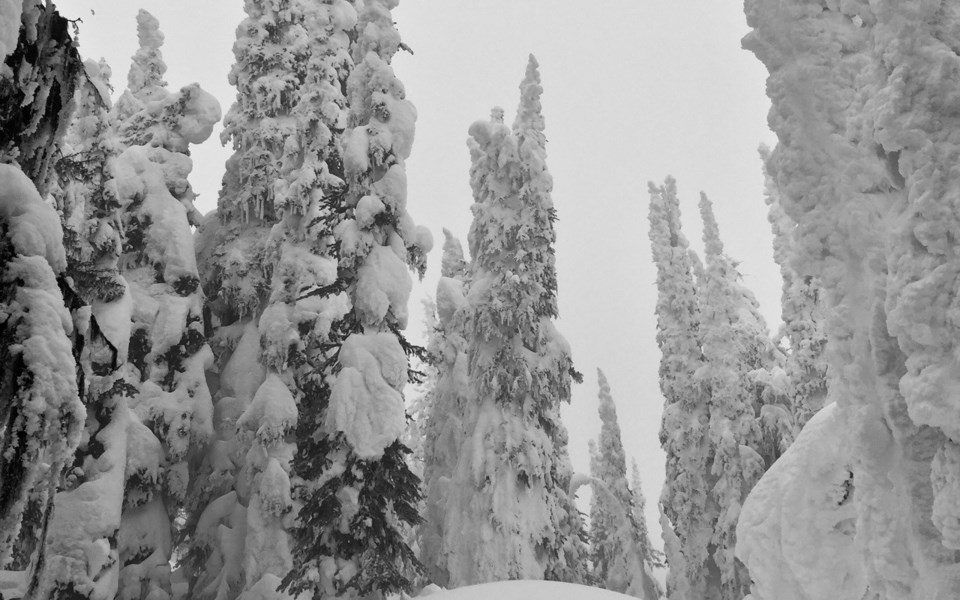I'm a lifelong liberal, and I love Canada," Howard Katkov tells me.
We're sitting in the infamous Start Shack, a tiny= building atop Rossland, B.C.'s Red Mountain Resort, chatting over wine after a solid morning of hard-ass skiing. As Red's owner since 2004, the 68-year-old Californian came onto the radar of the greater ski world for making ambitious terrain expansions while simultaneously preserving the culture and cachet of the famously down-home resort — and for the 2016 launch of "Fight the Man, Own the Mountain," a unique crowdfunding campaign ("Is Red Mountain an alternative to the ski industry's growing corporatization?" Pique, Nov. 16). But I'm not here to talk business. I'm interested in what drew him to this famous Kootenay backwater where snow ghosts — my mind's eye memory of Red — far outnumber people.
It all started when Howard met Telluride's famous "Captain Jack" Carey while skiing Vail. Always first in line together on powder days, they became fast friends. A starter at various International Freeski Association events, Jack had developed a deep affinity for Red, and for years encouraged Howard to visit this fabled hill in the Great White North. When he finally did, in February 2000, he and his wife ended up buying three lots in a development that was serviced but unbuilt. They began designing and erecting a house, trusting Jack's faith in the mountain's charms.
While this was coming together, Howard heard a rumour the mountain was going under. It wasn't, but it was looking for investment. Smitten, Howard bought the whole thing in 2004, after an amendment to the Official Community Plan reduced its commercial footprint and increased the residential quotient. "I wanted to make sure there was enough accommodation at the hill but didn't want to build a village. First, I hate clock towers, and second, I didn't want to disenfranchise Rossland, which is so close."
It led to all sorts of changes at Red, all of them good, most of which have only amplified the amazing skiing and good-times vibe. I've been a frequent visitor for 25 years, and on my first day there last March found it soft underfoot after a few days of snow, much of which — extraordinarily — was still untrammelled. We went up early with the Helly Hansen-sponsored patrol (Helly invests in sports not only through athlete ambassadors, but by promoting participation and industry pros; it seems fair symmetry for a 140-year-old company to partner with a 112-year-old ski area), following as they opened sectors and runs. Visibility was hampered by snow showers, then fog, then a mist that coated our goggles, requiring stops every minute or so to scrape clean. Skiing was superb.
Next day we headed off-resort to Big Red Cats. Principal and guide Kieren Gaul is a no-nonsense, get-things-done kind of guy, especially when it comes to skiing, something he clearly enjoys. After driving a half-hour to the staging area, we hopped in the cat to start on open cut blocks. After a few runs, we bumped over to another peak where it looked to be clearing. There, above the fog, we found super-deep snow — classic Kootenay bowling lanes and glades plunging downward into the murk. Lunching without stopping, we lost track of the number of runs, each ascent identically marked by snow ghosts looming outside the cat, as spooky as their name suggests.
The following day is Saturday. Amazingly, despite powder still hiding anywhere you care to look, there's hardly anyone there. Those that had come out lurked in Paradise Basin and other backside areas, making for lineups of — gasp! — up to five minutes. In most places, however, there was no one. We ride the frontside Motherlode Chair up Granite Mountain a full 15 minutes and see only one rider descending in all that time. Likewise, the Grey Mtn Chair. On Granite, we ski The Coolers and Beer Belly — crazy steep runs with massive but soft moguls. We even make a lap off the top with Red's own Mt. Kirkup Cat Skiing ($10 a lift!).
After pounding our legs into submission, we head back up to meet Howard at the Start Shack, which, like many, we have trouble finding. None of the lifties seem to know where it is, which is funny because when we finally do locate it, it's 50 metres from the top of the Motherlode Chair. I think the lifties have maybe been sworn to ignorance; this clearly keeps the riff-raff from over-running a place that's used by management for entertaining and during events.
The Start Shack only has enough room for about a dozen people, but there's a back deck with a barbecue and heated outhouse with snow-cut steps leading to it. Inside, we sit down to a great spread of appies, wine, beer, ski movies and old-school camaraderie. Howard and others are spinning stories. It immediately feels more like Europe than the Kootenays. In fact, as I look out the window at the snow ghosts leaning in as if to listen, the backwoods culture of Red feels... kind of fabulous.
Leslie Anthony is a Whistler-based author, editor, biologist and bon vivant who has never met a mountain he didn't like.




